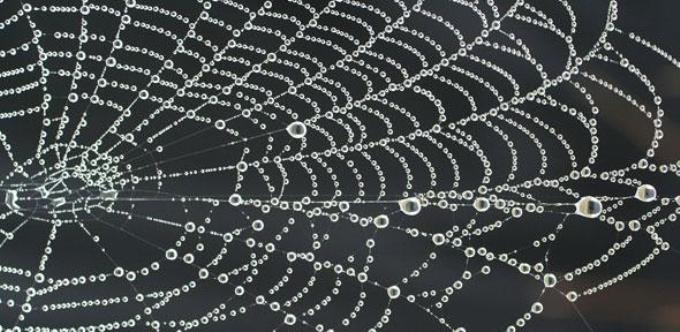Jul 11 2017
A team of Chemists and Architects from the University of Cambridge have created super-stretchy and strong fibers which are almost completely made up of water, and could be used to manufacture sensors, textiles and other materials.
The fibers, which look like tiny bungee cords as they can absorb huge amounts of energy, are sustainable, non-toxic and can be formed at room temperature.
 Spider web necklace with pearls of dew. (Credit: William Waterway)
Spider web necklace with pearls of dew. (Credit: William Waterway)
This new technique not only develops upon earlier techniques of making artificial spider silk, since it does not require high energy processes or extensive use of unsafe solvents. But it could considerably improve techniques of making artificial fibers of all kinds, since other types of artificial fibers also depend upon high-energy, toxic techniques. The results of the research have been published in the journal Proceedings of the National Academy of Sciences.
Spider silk is one of the strongest materials found in nature, and Scientists have been attempting to copy its properties for a variety of applications, with varying levels of success.
We have yet to fully recreate the elegance with which spiders spin silk C
Dr Darshil Shah, Co-Author, Cambridge’s Department of Architecture
The fibers created by the Cambridge team are “spun” from a soupy material known as a hydrogel, which is 98% water. The remaining 2% of the hydrogel is made of naturally available materials - cellulose and silica, held together in a web by barrel-shaped molecular “handcuffs” called cucurbiturils. The chemical interactions between the different components allow long fibers to be pulled from the gel.
The fibers pulled from the hydrogel, form long and very thin threads measuring just a few millionths of a meter in diameter. After approximately 30 seconds, the water evaporates, leaving a fiber which is both stretchy and strong.
Although our fibers are not as strong as the strongest spider silks, they can support stresses in the range of 100 to 150 megapascals, which is similar to other synthetic and natural silks. However, our fibers are non-toxic and far less energy-intensive to make.
Dr Darshil Shah, Co-Author, Cambridge’s Department of Architecture
The fibers possess the capacity to self-assembly at room temperature, and are bound together by supramolecular host-guest chemistry, which depends on forces other than covalent bonds, where atoms share electrons.
When you look at these fibres, you can see a range of different forces holding them together at different scales. It’s like a hierarchy that results in a complex combination of properties.
Yuchao Wu, a PhD Student, Cambridge’s Department of Chemistry and the paper’s Lead Author
The fiber’s strength exceeds that of other artificial fibers, such as cellulose-based viscose and synthetic silks, as well as natural fibers such as animal or human hair.
Besides its strength, the fibers also exhibit very high damping capacity, meaning that they can absorb huge quantities of energy, akin to a bungee cord. There are very few artificial fibers which possess this capacity, but high damping is one of the special features of spider silk. The Researchers discovered that the damping capacity in certain cases even surpassed that of natural silks.
“We think that this method of making fibres could be a sustainable alternative to current manufacturing methods,” said Shah. The research team plans to examine the chemistry of the fibers additionally, including making braided fibers and yarns.
This research is the result of a partnership between the Melville Laboratory for Polymer Synthesis in the Department of Chemistry, led by Professor Oren Scherman; and the Centre for Natural Material Innovation in the Department of Architecture, led by Dr Michael Ramage. The two groups have a shared interest in natural and nature-inspired materials, processes and their applications spanning different disciplines and scales.
The research received support from the UK Engineering and Physical Sciences Research Council (EPSRC) and the Leverhulme Trust.
Artificial spider silk
>p?
Reference
Yuchao Wu et al. ‘Bioinspired supramolecular fibers drawn from a multiphase self-assembled hydrogel.’ Proceedings of the National Academy of Sciences (2017). DOI: 10.1073/pnas.1705380114